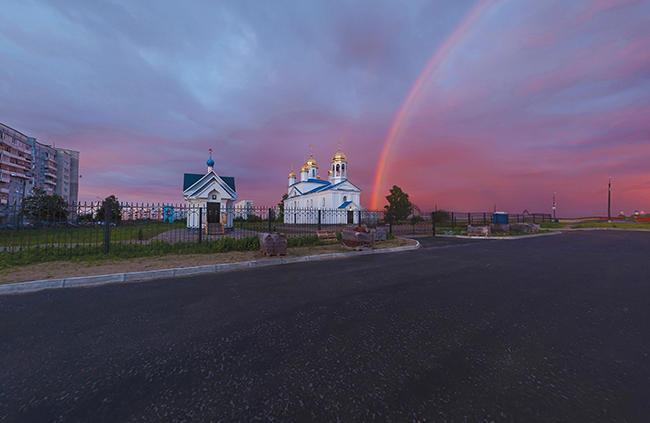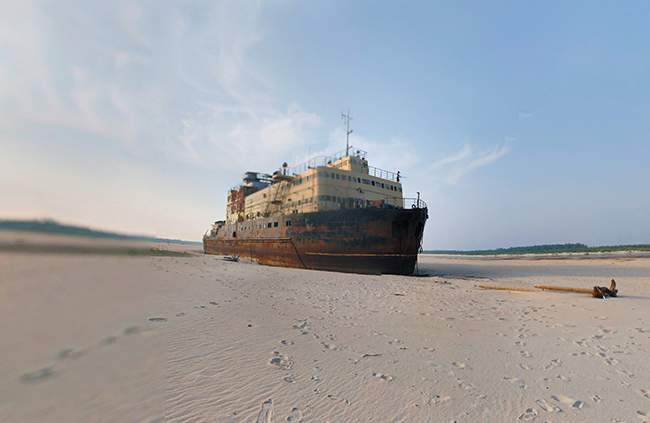
Leonardo Magrelli
Post-Photography of Leonardo Magrelli
TBILISI PHOTO FESTIVAL X FUTURES
Interview by René Mariam Nadareishvili
R. N.: The book West of Here is about the collective memory of people worldwide of the place that doesn't exist. It also describes the transformation of human minds influenced by technology. The photos were taken by gamers all over the world . Could you tell us more about the process?
L. M.: It started just before the first COVID-19 lockdown. I used to play this video game, which is called Grand Theft Auto. I used to play a very old version. So, during that period, December 2019, I started looking at videos of people playing this newest version of the game on YouTube, because I was feeling kind of nostalgic. And I was really impressed by the graphics. Also, I've been in Los Angeles, and it really impressed me how much it kind of resembled my memories of the place in the game. So, first of all, I started looking at these images. Then it started looking around, and I stumbled across a lot of websites, which are like blogs where people post the pictures that they take while playing. They take a screenshot of the place where they are having trouble. You can also program some patches that you would upload in the game. So, these are for free, developed by the players, and you can put this in the video game and the graphics are enhanced and work better. So, to show how much their program would enhance the graphic, they would post pictures while you played with this program. And what really fascinated me was that these are not photographers at all. These are players. So, I started collecting these images at first, as they kind of appealed to me. And then, one day I was playing with them when I switched them to black and white, and they immediately changed their nature. These images originally have very bright colors. They are easy to recognize as something beautiful that comes from a video game. So, there was the point that I started to think about doing something with these images. And the first thing that was clear to me was that this work needed to be a book. I started designing it as a book because I am also a graphic designer. And this was, I think, what appealed to Jennifer Yoffy. I pitched her the project and she really understood this. And so, we had the very same vision of making a book, and it's very classical. It has nothing contemporary. So, it kind of tricks you when you open it, and you see these images from L.A., which are again, very classical, very something that you might have already seen. Everything was designed to kind of lower your guard and make you believe these images are actual photographs.

Leonardo Magrelli. West of here. 2021
R. N.: In this book, there are two other authors who contributed with their essays. On one hand, you have a background of collaboration with authors and artists and on the other, a really strong artistic statement. How do you find the switches from individual to collective work and how, in your opinion, does it influence an artist?
L. M.: Well, first of all, when I'm working on my own, I really appreciate feedback from other people. In this case, it was the publisher, and we decided that we would find together the authors of the essays, which was really important to me. But of course, working alone is different, and I started working in a collective in 2017, almost by chance. I was approached by this girl that I've never met before. And she wrote to me on Instagram, telling me that she wanted to meet me and work together, and we met. There was also a friend of mine, and we started working together, almost naturally, on a project, and then we decided to keep on doing so because it's really fascinating when you work in a collective and collaborative way. If it works, of course, you always end up somewhere that you wouldn't on your own, of course, in the best cases. You all share your ideas and create something together. So, the output is never predictable, and it's almost never something that you can trace back to someone, to something that someone said, it's always like something completely different. And I think this is very nurturing. The main thing that I would say about this collaborative aspect, it requires that everything always must be said out loud, of course. So, the artistic gesture or the artistic in sensuality kind of fades out, because you have to talk about your idea, everything needs to go through the filter of language. And of course, this changes the practice very much from when you're on your own.

Leonardo Magrelli. The Long Way Home of Ivan Putnik. Truck Driver. Vaste Programme
R. N.: At the moment, you’re a member of the Vaste Programme. Your artistic group researches post-photography and new media. In one of your projects The Long Way Home of Ivan Putnik, Truck Driver you take a kind of anthropological emic approach and describe the country and culture using the visual perception of locals.
L. M.: We started working on the project a couple of years ago. It's the story of a Russian truck driver, and it spreads all across Siberia. The three of us had never been there. But the book is made of pictures that we found on Google Maps, taken by Russian users all around Siberia. And we asked ourselves a lot, when we were dealing with this project, that it probably was at least more interesting to show a country from the pictures taken by the people that live there, rather than going there for like three weeks a month, a couple of months and taking pictures yourself. You don’t know the culture; you haven’t lived their lives. It's very easy. So, there are many things that can be done with photography in the era of post-truth and digital manipulation. And if you are in the right direction, and you see where this brings you. In the origin, you can be more truthful to the photography and to the region of the image.

Leonardo Magrelli. The Long Way Home of Ivan Putnik, Truck Driver. Vaste Programme.
R. N.: Would you say you have a methodology, an approach that unifies all of your projects?
L. M.: Within Futures, we had three meetings with curator/critic experts in the field of photography. And they told us we could ask them whatever we want. I asked them to take a look at my portfolio. And looking back at my portfolio, it looks like it's made of many different things, which are not tied together. So, I wonder a lot about my work, and in the end, I think, the thing that lies underneath all of them is probably this idea that I continually have the ambiguity of the image. I started working as a graphic designer for trade books, commercial books. And I started working on images in a way that is not the way of a classical photographer in the darkroom, where you see the images born from the water. There is something kind of holy and sacred. When working on images, I take a picture from the internet, manipulate it, change the feature, like maybe the sky needs to be not blue, add something to it, like really meshing images together, and I think, having this done a lot of time made me very aware of how much ambiguous the image in this digital society is.
Cover image: Leonardo Magrelli. West of here. 2021
This series of articles are published in order to create new artistic opportunities for the Futures Talents - the photographers that are part of Futures platform. In 2020 Tbilisi Photo Festival has joined the FUTURES - Europe based photography platform co-funded by the Creative Europe program of the European Union. Futures bring together the global photography community to support and nurture the professional development of emerging artists across the world. The project implemented in partnership with Tbilisi Photography & Multimedia Museum.